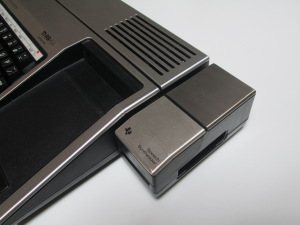Solid State Speech Synthesizer
 Texas Instruments Solid State SpeechTM Synthesizer |
The TI-99/4A Solid State SpeechTM Synthesizer (Model PHP 1500) is a peripheral add-on for the home computer system that added speech ability to some programs and games for the computer. Some of the popular titles that added speech content when the Speech Synthesizer was connected include Alpiner, Microsurgeon, and Parsec. The speech synthesizer could be purchased separately at first, and later on, was available as a free addition with some software titles that could utilize it, or in packages including the TI-99/4A and other software.
Contents
Summary
Solid State SpeechTM Synthesizer plugs into the side-car position on the right-hand side of either computer. The speech synthesizer contains a specific vocabulary. The speech synthesizer always needs to be plugged into the first side-car position even if using a peripheral expansion box (PEB). If other peripherals are used, the speech synthesizer always has to be the first peripheral, plugged in, closest to the computer, to work properly.
Initially, Texas Instruments (TI) intended to sell add on vocabulary cartridges that plugged directly into the speech synthesizer into the lifting door on the front of the unit. However; it was quickly realized that vocabulary expansion was easily achieved in software, therefore; the expansion cards were quickly disbanded and never developed or sold for the speech synthesizer. The speech synthesizer was one of the most purchased and available add-on modules around for the TI-99/4 - TI-99/4A system as it was given away near the end of the computer's life with software titles.
Third Party Speech Synthesizer Adaptors
Several third-party hardware vendors created adaptors and add ons specifically for the speech synthesizer. Some allowed the speech synthesizer to be moved into the PEB for example the CorComp Triple-Tech card or the Rave Speech Adapter.
Speech Synthesizer use in Extended Basic
Found on the Speech Editor cartridge comes the commands CALL SAY and CALL SPGET, which enables the use of speech synthesizer for Extended Basic programs. Full instructions for using this, however; were not provided. CALL SAY allows the speech synthesizer to SAY a word from the vocabulary. Words not found within the speech synthesizer's built-in database can be spelled out (phonetically) and still be said in those programs.
Manual
Important
Record the serial number from the bottom of the Speech Synthesizer and the purchase date in the space below. The serial number is identified by the words "SERIAL NO." on the bottom case. Always reference this information in any correspondence.
Solid State SpeechTM Synthisizer
Model PHP1500
Gives your TI Home Computer a voice of its own - adds new excitement and enjoyment to computer applications through spoken words, phrases, and sentences.
* Solid State Speech is a trademark of Texas Instruments
Solid State SpeechTM synthesis is a Texas Instruments innovation which constructs a human voice on a single chip of silicon (an integrated circuit). Without using traditional recording methods, such as tapes or records, you can:
- include spoken directions and comments in programs you write
- combine verbal and visual reinforcement in programmed educational activities
- add sound effects and comments to games
- give instruction to non-readers
Note: A specialized Solid State SoftwareTM Command Module must be plugged into computer console to activate the Speech Synthesizer. You can use the Speech Editor Command Module or any other module which is programmed for speech, such as Early Reading Command Module.
The Speech Editor Command Module gives you instant access to the nearly 400 words and phrases in the Speech Synthesizer's resident vocabulary (see page 10). You can arrange them in any order, creating the phrases and sentences you want the computer to say. Also, by selecting TI BASIC when this Command Module is plugged into the console, you can utilize the subprograms, CALL SAY, and CALL SPGET, to write your own "speaking" programs. (These features are explained fully in the manual that accompanies the Speech Editor Command Module).
Certain other Command Modules are also programmed to work with the Speech Synthesizer. While you're using one of these modules, the computer "talks" its way through the activities using the Speech Synthesizer's resident vocabulary, plus any additional words or phrases contained in the Command Module itself. You'll hear directions, encouragement, and praise for good moves and promptings when an incorrect entry is made.
For Further Information
The following articles contain discussions of speech synthesis technology:
Larry Brantingham. "Speech Synthesis with Linear Predictive Coding." Interface Age, June, 1979, pp. 72-75.
N.C. Pearson. "Electronics Speaks Out." Design News, April 9, 1979, pp.76-79.
Richard Wiggins and Larry Brantingham. "Three-Chip System Synthesizes Human Speech." Electronics, August 31, 1978, pp. 109-116.
Set-Up Instructions
The Speech Synthesizer is designed to be a permanent addition to your computer system. Once installed, it is best left in place. The unit will perform its duties whenever it's called upon. When not in use, it has no effect on the other operations of your computer. No additional power source is necessary to operate the Speech Synthesizer, since it receives all of its power requirements from the main console. Whenever you connect more than one accessory (including the Speech Synthesizer) to your computer, the Speech Synthesizer must be connected to the console first. Two other accessories can be connected in line to the right of the speech unit.
